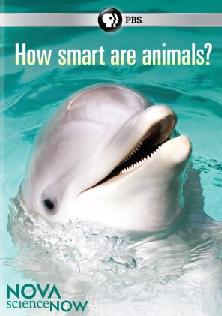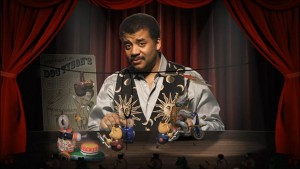BEYOND NEAT TRICKS
When Neil deGrasse Tyson, the host of the video magazine NOVA scienceNOW, was a guest on The Daily Show recently, Jon Stewart complimented him for finally “making science cool.” And it is cool to have Tyson, an approachable, gentle presence, representing the wonders of science. If only we’d had someone like him as our science teacher, many of us would have been much more enthusiastic about school.
The season currently being promoted on DVD (having already aired on TV earlier this year) asks six big questions, and takes an episode to explore each answer, with mixed results. It is aimed at children, and it assumes that their attention will not be hooked for long, so during Tyson’s talky sections of the episode “How Smart Are Animals?,” animated animal figures pop up from all corners of the screen, not so much illustrating what he’s saying as distracting the viewer from listening.
So how smart are animals? We’ve seen animals do tricks, but can they reason? Make plans? Be creative? Come on, animals, show us your smarts. It turns out they aren’t so dumb, as we learn from a dog that can identify 1000 toys by name and then identifies one he’s never seen before by the powers of deduction; an octopus that learns how to open a jar to get to a yummy shrimp treat inside; another octopus, this one chameleon-like, that changes its shape, color, and texture to blend in with its surroundings (as seen with footage that’s been on the internet at least since 2007); a parrot that can vocally count and identify shapes; and other examples.
This episode has a bit of problem with lucidity. In explaining the octopus that mimics its environment, graphics were overlaid that seemed at first to be part of the creature’s amazing ability to change. A segment on dolphins collaborating on a creative achievement had to be watched three times before this reviewer understood exactly the amazing feat on hand. And Tyson’s wrap-up at the end (mercifully free of the imposing animated distractions) also had to be watched more than once to “get” what he was saying. It wasn’t because the concepts were too difficult for an adult to understand; they simply weren’t presented clearly – which is somewhat odd, considering the very young target audience.
This reviewer was also given the season opener, “Can We Make It To Mars?,” which he hadn’t intended to watch, but is glad he did.This episode, about the aspirations and obstacles we face in making our first human voyage to Mars, was much more comprehensive, more interesting, and less distracting. It was similarly kid-friendly, but not obnoxiously so (animated figures jumping out from nowhere didn’t exist); Tyson’s natural sense of humor was more on display; and the information presented was cleaner and tighter. Based on these two DVDs, it would seem that the “Final Thoughts” wrap-up talk at the end has made it a tradition for Tyson to unbutton his jacket and, with hands on hips, reveal his cool vest underneath (the unnatural, studied, and perfectly executed gesture makes it one of the most memorable moments in both episodes).
It was a thrill that the series redeemed itself with the second DVD, because, if you are like this reviewer, you can watch nature and science porn like NOVA scienceNOW all day. In fact, JetBlue flights wouldn’t be the same without them.
NOVA scienceNOW
Season 5: Episodes 1 “Can We Make It To Mars?” and 4 “How Smart Are Animals?”
now available on DVD from PBS Home Video

